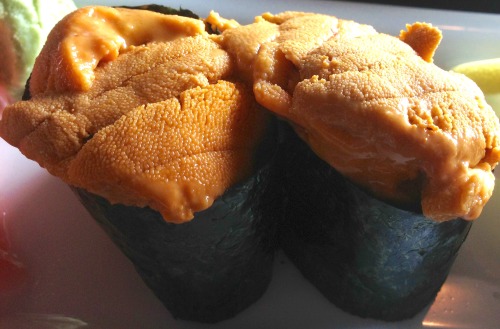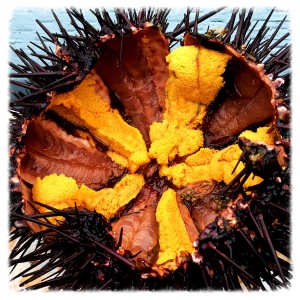“…what’s uni?”
If I had a dollar for every time someone’s ever asked me that, it’d be enough for a nice little splurge at Sushi Nakazawa (top of my NYC bucket list right now!). So…even though I think it’s best understood through love at first bite, here’s a crash course on the basics of the wonder that is uni.
What is uni?
Pronounced oo-nee (aka not you-nee), uni is the Japanese word for sea urchin. Covered in sharp spines, the real gem of course is what’s inside the shell – edible pieces that range in color from a light yellow to a rich orange hue depending on variety, and almost resembling a tongue in shape and outer texture.

But what are you actually eating? A lot of people, including sushi aficionados themselves, commonly mistake it as being the roe – or eggs – of the shellfish. In reality, that’s not far off but they’re actually its gonads (aka sexual reproductive organs, of which each sea urchin has 5 total). Yum, right?

How many varieties of sea urchin are there?
According to Chef Masa (formerly of 15 East) when I asked him several months back before he left, there are hundreds of different varieties found in every ocean around the world, but only 18 (!) are edible. Here in the U.S., the most prevalent varieties that you see available hail from Santa Barbara (California), Hokkaido (Japan), and Maine.
What does sea urchin taste like?
Second to what uni is, this is the most common question that I get. Those of us who know and love uni know its mind-blowing taste isn’t the easiest to describe because of its one-of-a-kind flavor profile. Umami at its best, I like to think of it as the foie gras – or even ice cream – of the sea. Depending on the variety, diet, and gender, good uni is firm but melts in your mouth with its rich and creamy sweetness, and is just a little bit slimy (a good slimy, I swear!). It’s almost a bit custard-like – but lighter. And important to note, good uni is never fishy but instead, has delicate traces of the ocean.

By and far, it seems to be a love or hate kind of thing when it comes to uni as people tend to fall on either side of the extreme, but I’m convinced at least half of those who claim to “hate” uni and find it gross first tried it at a subpar restaurant that was serving out-of-date, low-quality uni. Ew.
How can you tell good uni from bad uni?
Great question. Sea urchin is differentiated by grade and as per above, low quality leads to not-so-good experiences. And when it comes to quality, according to the California Sea Urchin Commission (yes there really is such a thing, believe it or not), a few different factors come into play: taste, color, freshness, and texture.

“California Gold” is the highest grade – always fresh, bright and vibrant in color (very autumnal if you ask me), and firm in texture but again, still manages to be melt-in-your-mouth sweet and delicious. It’s as good as it gets. “Premium California” is up next – still great, but slightly milder in color and a tad softer in texture. And finally, there’s “Select California” – the last tier before things start to go a bit downhill. These are darker in color, less firm and more liquid-y in consistency, thus veering closer to that fishiness you 100% want to avoid.
What are the differences between different varieties of uni?
Again, uni taste and texture really depend on a bunch of different factors: region, gender, diet, etc. I’ve been lucky enough to have had uni from quite a few regions before: Santa Barbara, Catalina, Maine, Hokkaido, Aka, North Korea, Dalian, Chile, Canada, Italy, the Philippines, and more. Each region features uni with a very distinct taste, and there’s nothing more fun than taste testing and comparing/contrasting.

Personally, I find Santa Barbara to be the sweetest; Hokkaido, the smoothest; Italy, the saltiest; Maine, the most custard-like; the Philippines, the silkiest; Chile, the least distinct. But despite the minute differences from region to region, fresh uni always have a few things in common: sweet taste, creamy texture, and ecstasy-inducing ocean essence. Drool.
Why is sea urchin always one of the most expensive items on a menu?

As you can probably imagine, uni isn’t exactly easy to raise or harvest, and each sea urchin itself only contains 5 edible pieces – and super fragile pieces at that. Plus, if not eaten as fresh as possible, the quality takes a serious nose dive. And of course, depending on where you are, the uni may be imported from a number of different corners of the world which, of course, comes at an additional cost. Just believe me when I say it is SO worth it.
How is uni prepared? What are different ways to eat it?
…the possibilities are ENDLESS. In the last couple decades especially (and last few years, on over-drive), sea urchin has gone from being a popular delicacy in Japan only to a common ingredient seen on menus in all corners of the world. From Mexican to Chinese, Italian to French, chefs know the demand is there and have been responding accordingly.

Of course, nowhere is more common to see uni than in Japanese/sushi restaurants where it’s typically served in its most delectable form – rare and au naturel. Other ways I’ve had it: as a pasta sauce and topper, grilled or torched in a tray, charred on toast, together with an oyster, marinated, pan-seared with bibimbap, atop an uni-flavored chip with an uni glaze, in a shot, as part of flan, mixed with raw squid, in a panini, as mousse paired with lobster…and the list goes on and on and on.
Uni must be unhealthy though, right?
Nope! I like to call this Uni Mythbusting 101. If you’re counting calories, uni only has about half as many calories as unagi (eel), ankimo (monkfish liver), iwashi (sardine), and saba (mackerel)…and fewer calories than hamachi (yellowtail), hokkigai (surf clam), maguro (bluefin tuna), sake (salmon), shiro maguro (white tuna), and tako (octopus)! Seriously.
Now, I do know that a lot of people will talk about uni having a high amount of cholesterol. Technically, this is true – but once you dive a bit deeper, it turns out that while sea urchins do contain fat (though less fat than most of the other fishes listed above), nearly all of it is healthy fat that actually helps to lower your cholesterol and blood pressure.
Plus, it has zero carbs, is super rich in vitamins A, C, and E, and is a healthy source of protein, zinc AND calcium. Um…#winning.
What is your favorite type of uni?
Hardest question EVER…ugh. They all taste like pure ocean gold to me, but if forced to choose, I’d say I’m partial towards California uni. Santa Barbara uni especially tends to be larger, meatier, and jam-packed with SO much sweetness…yes please.


There’s definately a great deal to learn about this subject.
I like all of the points you’ve made.
LikeLike
Thanks! #unilove
LikeLike
Color to taste may be accurate when it comes to Santa Barbara uni but this is definitely not the case for all varieties. I had a Japanese uni once in Tokyo that was dark in color almost brown definitely what super low grade SB uni would look like but chef assured me it would be good and indeed it was amazing, very sweet in taste. He referred to it as “special uni from hokkaido”
LikeLike
Super interesting. Would love to see a picture of that! Hokkaido uni is very prevalent here in the U.S. and is always that same yellowy-orange hue, never brown. Very curious to see/try that.
LikeLike
I believe this was at Iwa in Ginza. I didn’t take a picture.
In the US and even in Japan when you ask the chef where their uni is from if it is from Hokkaido that is what they will say. Of course there are at least 3 types of uni in Hokkaido (Bafun, Murasaki and Aka) and also there are multiple parts of the island where uni is harvested. I’ve had difficulty getting a more precise answer when in Japan due to language barrier but I’ve had chefs take out a map and point 🙂
Oh and I realize I am replying a year and a half later, oops. I guess I never received a notification and forgot about my comment here.
LikeLike
Wow! Your post made me drool. I have recently acquired a taste for uni and it’s definitely here to stay. Both fortunately and unfortunately for me, it is not yet that popular here in the Philippines so restaurants serving good uni are limited and tend to be pricey. May I ask where in Philippines you had uni and in which restaurant? Thank you so much!
LikeLike
I posted a picture which I incorrectly titled sea urchin feeding and you responded with exclamation marks which made me curious So a search ensured and I came to realise that my picture was instead of anenome Thank you for the education all about urchins and especially them as a food.I am now keen to try If I can ever find it in my small city of Adelaide Australia
LikeLike
Hi there
I’m going to be in Hokkaido this January. Do you have any idea where I should eat uni in Hokkaido? Our main activity is going to be skiing in Niseko, but I can’t leave without liberal doses of uni.
Thanks
LikeLike
I wish! I’ve never been but my guess is it will be relatively easy to stumble across uni…and I’m already envious of how incredibly sweet and fresh it’s going to be! Enjoy.
LikeLike
Hopefully you made it out to Otaru or to any of the major fish markets in Sapporo. Difficult to find bad uni in any of the restaurants there.
LikeLike
anything about russian uni ??
LikeLike
I’m jealous of the fact that you can enjoy uni! I have tried it 5 times, including at least once at a fish port in Japan (so super fresh), and it was inedibly bitter to me every time. Looking into it, it turns out that there is huge variety between people’s bitter taste receptors (mostly due to genetics), so I’m figuring I might just have lots of the taste receptors that taste the particular bitter taste in uni 😥
Has anyone else had this experience?
LikeLike
[…] Bonus: What is uni? […]
LikeLike
[…] The Uni Diaries: everything you ever wanted to know about uni. […]
LikeLike
[…] After my experience at a local sushi restaurant where I live (http://www.senzushi.com/), I did some research to find out what I really ate. Check out the Uni Diaries to set the record straight (https://theunidiaries.com/2015/11/15/what-is-uni-sea-urchin-101/)! […]
LikeLike